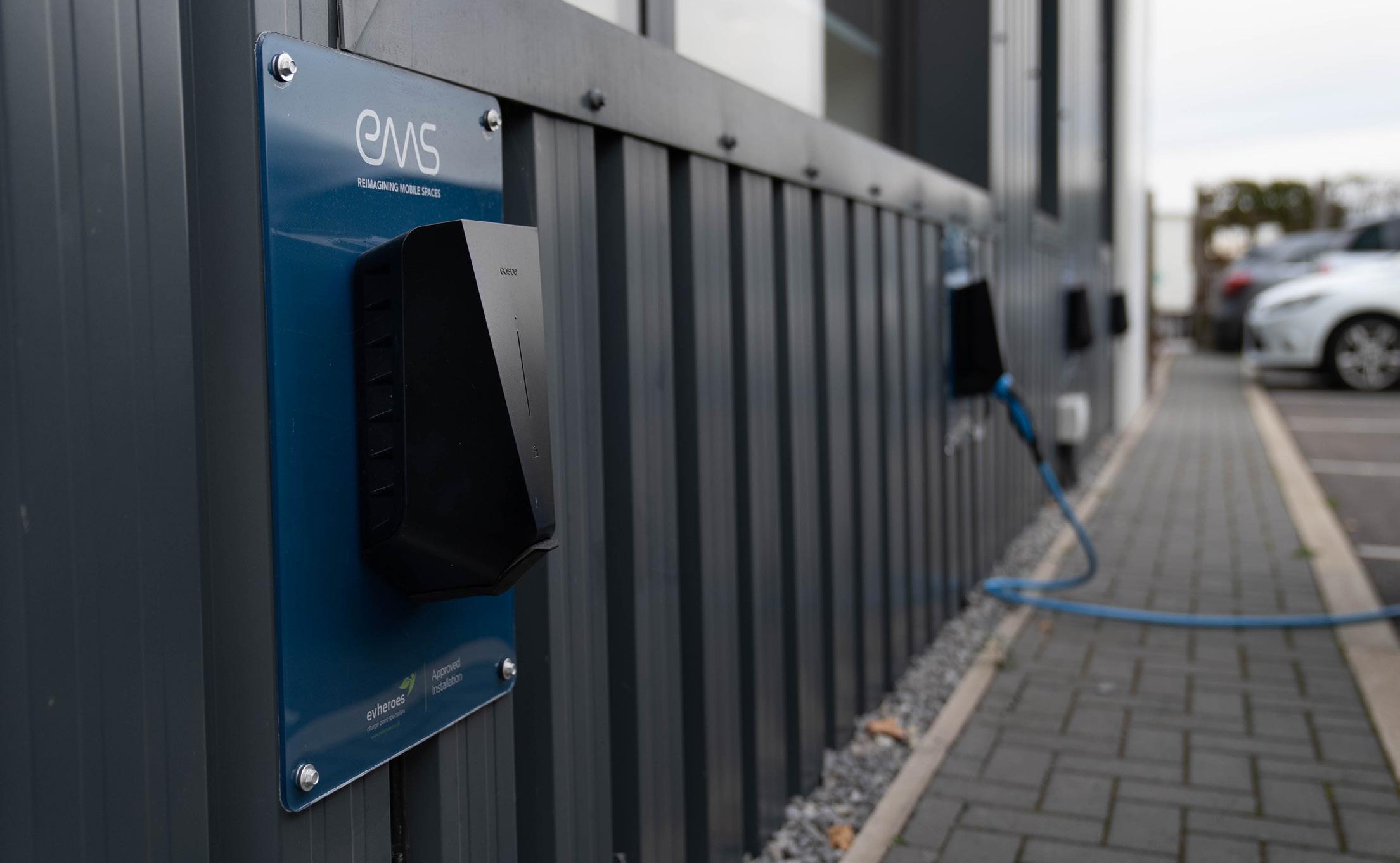









Dr Clare Grace, Chief Executive Officer
I am proud to present the progress we are making on our sustainability journey in EMS Healthcare’s third annual Net Zero Report.
We defy all limits
Since achieving carbon neutrality in 2021, we have continued to push forward with purpose toward our Net Zero 2045 ambition. Through the Science Based Targets initiative (SBTi), we are assessing climate risks and embedding mitigation strategies across our operations. This year, we achieved a 69.4% reduction in total emissions compared to our FY21 baseline, demonstrating meaningful progress in line with our long-term goals.
We drive momentum
Our environmental impact has reduced significantly as we invest in cleaner technologies and smarter operations. The salary sacrifice scheme for electric and hybrid vehicles has been very popular, positively impacting our company mileage and employee commuting Carbon emissions. We began the preparations for HVO fuel storage and refuelling, and continued to expand our use of renewable energy across our estate. These actions are helping us transition our fleet and facilities toward lower emissions and greater efficiency.
We ensure excellence
Sustainability is not just a target - it’s part of how we operate every day. We continue to uphold the highest standards of ethical conduct and compliance, while improving waste management and resource efficiency. Through standardised waste segregation and food waste composting, by collecting directly from our community research sites for triaging at our head office, we are reducing environmental impact and embedding sustainable practices across our business.
We champion collaboration
Our people remain at the heart of our progress. The Colleague Committee, guided by our Environmental Champion, continues to inspire collective action and new ideas to further reduce emissions. This year, we introduced rescued chickens from a local battery hen farm to our team. They consume our food waste, deliver an egg each nearly every day, and are a great addition to our Mental Health support plan. Together, we are building a culture that values sustainability, well-being, and community impact - ensuring our services create positive change for both people and the planet.
Together, we can shape a healthier, more sustainable future - one where good health is truly within everyone’s reach.
“Together, we can shape a healthier, more sustainable future - one where good health is truly within everyone’s reach.”
Dr Clare Grace, Chief Executive Officer


At EMS Healthcare, we are committed to playing our part in supporting the UK’s journey to a low-carbon future. We stand alongside other UK organisations in working towards the UK Government’s Net Zero target of at least a 90% reduction in net greenhouse gas (GHG) emissions by 2050 (based on 1990 levels).
Going beyond the national goal, EMS Healthcare is targeting Net Zero emissions across our operations by 31st December 2045 - five years ahead of the UK Government’s timeline.
To achieve this, we are taking decisive action to reduce our emissions year-onyear, guided by science-based targets and a commitment to continual improvement:
47%
Since 2021
Reducing our Scope 1 & 2 emissions by 2030
90%
Annually offsetting our Scope 1 and 2 emissions with high-quality verified offsets to maintain carbon neutrality since 2021
By 2045, the organisation aims to reduce all greenhouse gas (GHG) emissions across Scopes 1, 2 and 3, offset any residual emissions via high-quality nature-based or direct air capture projects, and become Net Zero
To achieve these goals, EMS Healthcare has taken the following actions:
1. We have used Equipoise Advanced Business Carbon Calculator, in partnership with the SME Climate Hub to collate and verify data, calculate our carbon emissions and help advise on carbon reduction options.
2. Set the base year (January 2021 - December 2021) and calculated our GHG emissions footprint in line with the GHG protocol for that base year:
Mobile combustion (owned & leased vehicles)
The Scope 3 Standard complements and builds upon the Corporate Standard to promote additional completeness and consistency in the way companies account for and report on indirect emissions from value chain activities.
Refrigerants
Scope 3
Category 1 - Purchased good and services
Category 2 - Capital goods
Category 3 - Fuel and energy
Category 4 - Upstream transportation
The Corporate Standard classifies a company’s direct and indirect GHG emissions into three “scopes,” and requires that companies account for and report all scope 1 emissions (i.e., direct emissions from owned or controlled sources) and all scope 2 emissions (i.e., indirect emissions from the generation of purchased energy consumed by the reporting company). The Corporate Standard gives companies flexibility in whether and how to account for scope 3 emissions (i.e., all other indirect emissions that occur in a company’s value chain). Figure 1.1 provides an overview of the three GHG Protocol scopes and categories of scope 3 emissions.
Since the Corporate Standard was revised in 2004, business capabilities and needs in the field of GHG accounting and reporting have grown significantly. Corporate leaders are becoming more adept at calculating scope 1 and scope 2 emissions, as required by the Corporate Standard. As GHG accounting expertise has grown, so has the realization that significant emissions – and associated risks and opportunities – result from value chain activities not captured by scope 1 and scope 2 inventories.
Category 5 - Waste
Category 6 - Business travel
Scope 3 emissions can represent the largest source of emissions for companies and present the most significant opportunities to influence GHG reductions and achieve a variety of GHG-related business objectives (see chapter 2).
Category 7 - Employee commuting & WFH
Category 13 - Downstream leased asset
Developing a full corporate GHG emissions inventory –incorporating scope 1, scope 2, and scope 3 emissions –enables companies to understand their full emissions




This marks the fourth consecutive year that EMS Healthcare has measured and reported its greenhouse gas (GHG) emissions, enabling us to track progress against our established baseline and reduction targets. Our baseline emissions represent the volume of greenhouse gases generated before implementing our current sustainability initiatives and serve as the reference point for all future comparisons.
By benchmarking each year’s performance against this baseline, we can clearly measure our progress toward Net Zero, celebrate the areas where significant reductions have been achieved, and identify where further improvements are needed.
In FY24, EMS Healthcare recorded a total market-based GHG footprint of 2,167.1 tCO2e, reflecting a 69.4% reduction since FY21 - a strong indicator of our commitment and the effectiveness of our ongoing decarbonisation efforts.











We monitor our greenhouse gas emissions across key efficiency measures - per employee, per square metre, and per £1m turnover - to understand how our growth aligns with our sustainability ambitions.
These indicators show how we’re improving energy efficiency and reducing emissions intensity across our operations.
tCO2e Per employee (End of the year)
tCO2e Per Square Metre
tCo2e Per Million £ Turnover


The glidepath that follows brings these insights together, showing our total emissions over time and our ongoing commitment to reaching net zero.
Significant emission reductions were achieved across multiple categories.
Capital Goods & Services fell by 84.4%, reflecting reduced capital expenditure and improved supplier efficiency.
Waste-related emissions dropped by 98.9% following the introduction of standardised waste segregation and composting.
Fleet fuel emissions increased by 30.6% due to operational demand, but EMS Healthcare is addressing this through fleet decarbonisation and the planned transition to HVO fuel.
Scope 3 emissions remain the dominant contributor (91.8% of total emissions), driven largely by leased asset operations and supply chain impacts.



6.1 Environmental
Fleet De-carbonisation
Target:
Action:
Promote uptake of EV salary sacrifice, launched a new platform that also includes Hybrid to encourage more employees to sign up.

HVO Fuel Transition
Target: 80% of diesel vehicles and generators to be refuelled with HVO by the end of 2026

Action:
Assess supply availability and ensure safe on-site storage and refuelling procedures.

Target: 40% reduction in all waste, compared to the 2014 baseline

Action:
Standardise waste segregation procedure at HO and on-board the Community Research Site. Compost all food waste.

Target:

Action:
Report Scope 1 and 2 carbon emissions via the EcoVadis platform for 2024 and initiate the certification process.
Staff Well-being
Target: 85% Employee satisfaction score in annual staff survey

Action:
Enhance staff benefits and launch a new platform to promote all that is on offer, including staff recognition.

Target: Facilitate 150,000 patient and participant interactions through mobile clinical services and community research sites

Action:
Published a social impact survey to promote access to care improvements delivered using the EMS mobile offering.
Menopause Support
Target: Implement a Menopause awareness and support programme across the business
Action: By Q3 2025 train all managers on menopause awareness and establish menopause champions within the Colleague Committee.



ESG Integration
Target: ESG considerations embedded into all new business tenders and supplier contracts
Action: Implement an assessment of suppliers ESG and code of conduct as part of the vendor validation process.
Staff Well-being
Target: Implement a Learning Management System (LMS) to centralise staff training, compliance tracking and professional development
Action:
Integrate and roll out the LSM to the current HR Software, draft training plan by department by Q3 2025.

Over the past year, we’ve taken meaningful steps toward achieving our ESG goals, and we’re proud of the progress made so far.
While the journey is ongoing, our actions are already making a difference.
We established a company charity of the year, chosen annually by our employee of the year
We have 15 EV charging points installed at our HQ, available for both employees and visitors
We introduced our first electric vehicle in 2021, complete with solar PV to boost on-board power
All our vehicles are Euro 6 certified, ensuring compliance with the latest emission standards
We use only renewable electricity and gas, with roof solar panels generating 109,077kWh of electricity per year
EMS Healthcare has demonstrated strong and measurable progress towards its 2045 Net Zero commitment. With a 69.4% reduction in emissions since FY21, the business is on track to deliver continued improvements through FY25 initiatives.
Ongoing efforts across fleet decarbonisation, renewable fuels, and ESG integration ensure sustainability remains embedded within EMS’s operational strategy and corporate culture.
This Carbon Reduction Plan has been completed in accordance with PPN 06/21 and associated guidance and reporting standard for Carbon Reduction Plans.
Emissions have been reported and recorded in accordance with the published reporting standard for Carbon Reduction Plans and the GHG Reporting Protocol corporate standard 13 and uses the appropriate Government emission conversion factors for greenhouse gas company reporting 14.
Scope 1 and Scope 2 emissions have been reported in accordance with SECR requirements, and the required subset of Scope 3 emissions have been reported in accordance with the published reporting standard for Carbon Reduction Plans and the Corporate Value Chain (Scope 3) Standard 15.
This Carbon Reduction Plan has been reviewed and signed off by the board of directors (or equivalent management body).
Signed on behalf of the Supplier:

Date: 07.11.2025

Published: November 2025